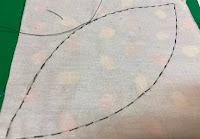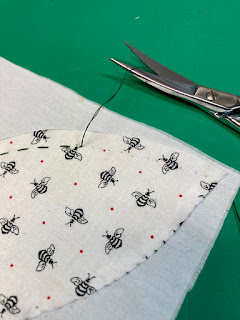
The convertible was in need of some maintenance this weekend. Luckily, the new applique to go bag was in my tote with a new pack of Kona Ash 5" charms. I used my time to prep some more melons for back basting method using my actual size template and a regular pencil on the backside of the fabric pack. The 42 charms were finished quickly, which left plenty of time to make a couple new friends before the car was ready.

I'm terribly aware that I need to get my new eye glass prescription. As a result, the remaining prep is in limbo. So far, the Lizzy House Pearl Bracelet (and Mini Pearl Bracelets) are in the lead for the focus fabrics. I just love polka dots and think the irregular dots on the bias cut will have an interesting overall look. Of course, there's the gorgeous Aneela Hoey Foxglove line (OOOH AHHHH) and the super fun recent Heather Ross goodies, too. As you can see, there are some adorable options to consider.
Originally, I wanted to use just one focus fabric and who knows? Maybe that's what I'll end up doing. If so, I'm leaning towards the navy original Lizzy House pearl bracelet.
For those of you appliqueing along with us, if you're interested in using charm packs rather than cutting your own background fabrics, you can use the 5" charms or the larger 10" layer cakes. For the layer cakes, you'll need to plan on 4 (small template) melons per 10" piece. I'm sticking to the 5" charms so I don't have to think about my handwork to be honest. Each 5" charm can be set up the same way and becomes somewhat automatic as you get further along in the process. That autopilot handwork is what helps ease anxiety and lower blood pressure. The smaller size also allows you to move your melons around, which can be really helpful to those of you using directional prints and of course allows you to play around with the layouts. Do you want the Xs to be the same print and the Os to be mixed or would you rather have the Os the same color? Would you like just the petal look to show in rows? That's certainly an option, too. I don't usually know exactly what the final project will look like until I'm finished with the exception of Dear Jane...that planning is next level and I think that's why I'm just going with the flow on this project.

I have never attempted hand sewing blocks but am certainly willing to give that a try if you are not planning to use a machine at any point. Please just let me know so I can research and get a tutorial together for you, if that's of interest. Also, if you're in Chicagoland and need a machine, I have several and am working on downsizing, thanks to the recent Viking purchase (YAY!).
If you're using the
5" charm packs for background fabrics, please check out the size list here.
For the
10" layer cake size backgrounds, see the counts per size here. Most of the sites say 2 packs for queen, up to 3 for King. Please keep in mind, you'll have to be careful with the planning of the layer cake size if you're using the "small" melons, less so if you purchase the larger Missouri Star template version.
As always, if you get stuck and need some assistance, please reach out and we'll get a video conference set up. Additional
applique tutorials are available via the tab just beneath the header.
Happy Applique,
Heather





































































